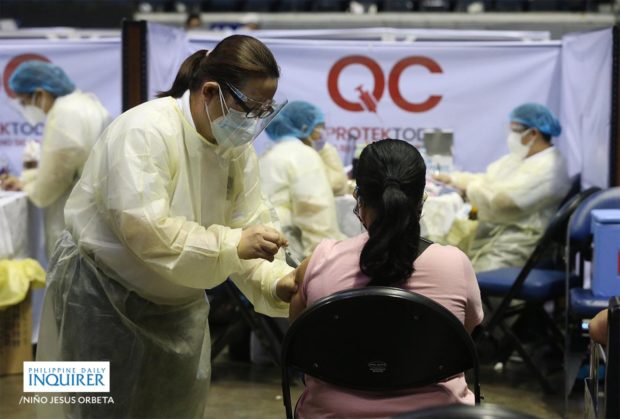
Health workers, frontliners, senior citizens and persons with comorbidities receive anti-Covid-19 vaccination at the Smart Araneta Coliseum Mega Vaccination Center in Quezon City on May 15 (Niño Jesus Orbeta/Inquirer)
MANILA, Philippines—Amid complaints against what critics said was the slow coronavirus vaccination rollout in the Philippines, vaccine czar Carlito Galvez announced that more doses had already been administered based on the government’s priority list.
According to data presented by Galvez at President Rodrigo Duterte’s pre-recorded address to the nation aired on Tuesday (May 18), the number of doses already administered had increased from 2,539,693 to 3,001,875 as of Sunday (May 16).
READ: COVID-19 vaccine doses administered in PH breach 3M as of May
The number of people, who got their first dose, increased to 2,282,273 from 2,025,038.
Current data also showed that at least 719,602 people had already received their full shots of vaccines that required two doses. The government has so far given shots to 1.24 percent, or 1.03 percent, of its target of injecting 58 million to 70 million people to achieve herd immunity by the end of 2021.
Galvez said the rate of inoculation has now climbed to 120,000 from 30,000 per day.
At this rate, it would take 477 days, or at least 16 months, for the government to hit its target of giving shots to 58 million people. To hit the 70 million target, at least 577 days, or 19 months, would be needed.
Galvez, however, expressed optimism that the Philippines will reach its herd immunity target by giving full doses to 58 million to 70 million by November 2021.
READ: ‘Better Christmas’ seen as PH gets herd immunity by November
To achieve this goal, the government must give at least 300,000 to 350,000 shots per day.
The Philippines has so far received a total of 7,779,050 doses of different vaccine brands—Coronavac, the vaccine manufactured by Chinese firm Sinovac, AstraZeneca, Pfizer-BioNTech, and those made by Gamaleya Research Institute. Of this, according to Galvez’s data, 6,408,640, or 83 percent, had already been distributed nationwide as of May 11.
RELATED STORY:
Gripes aired over slow pace of COVID-19 vaccine rollout
TSB